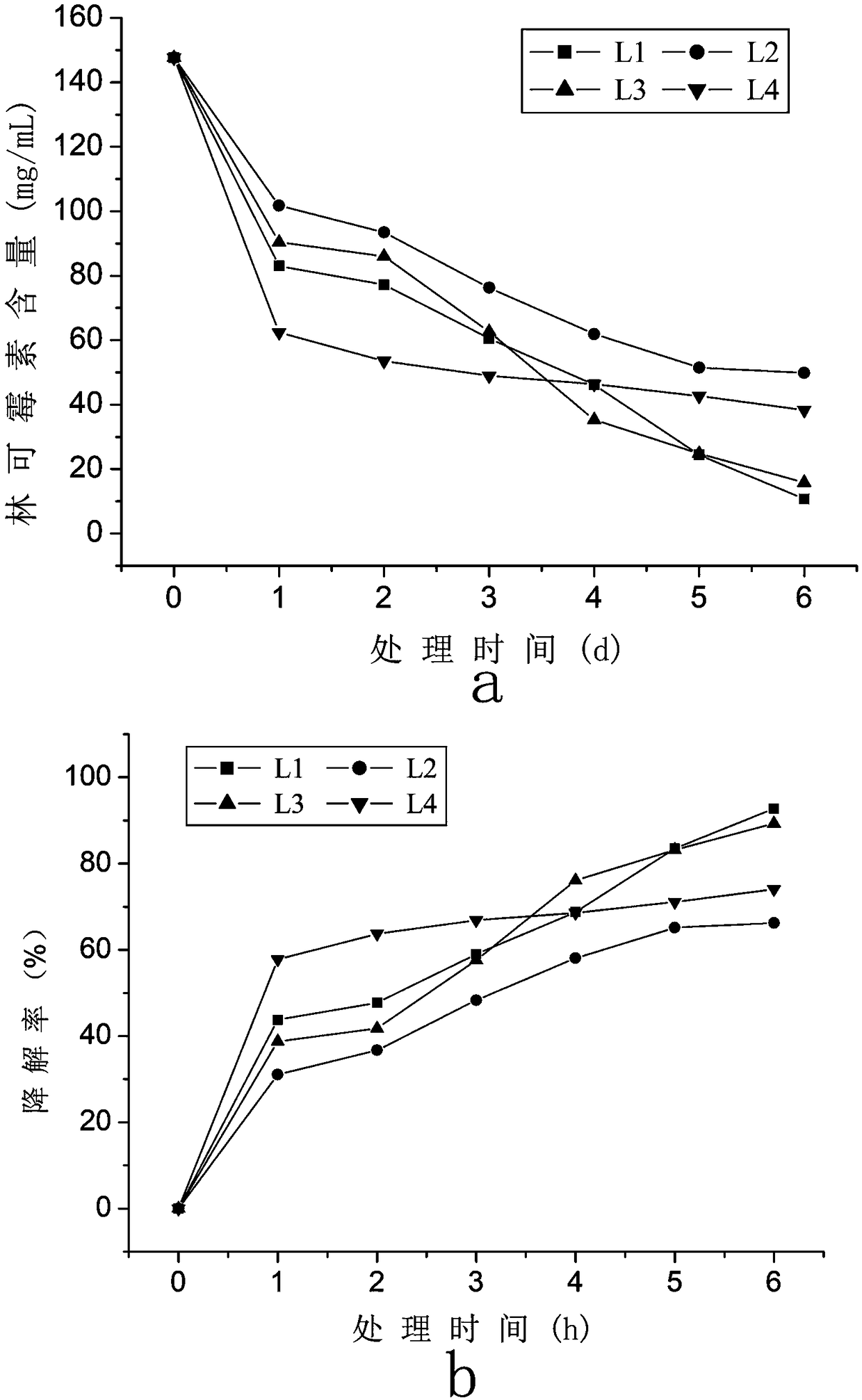Bacillus subtilis L1, and application thereof in degradation of lincomycin residual in lincomycin residues
A technology of Bacillus subtilis and lincomycin, which is applied to bacteria, microorganism-based methods, microorganisms, etc., can solve the problems of increasing difficulty in the composition of antibiotic bacteria residues, secondary pollution, and rapid decay of bacteria residues.
- Summary
- Abstract
- Description
- Claims
- Application Information
AI Technical Summary
Problems solved by technology
Method used
Image
Examples
Embodiment 1
[0026] Screening and identification of embodiment 1 bacterial classification
[0027] 1. Strain screening
[0028] Broth agar medium mass final concentration composition: peptone 1%, beef extract 0.3%, sodium chloride 0.5%, agar 2%, solvent is water, pH value 7.4.
[0029] Dilute the sewage obtained from the aerobic tank of Henan Tianfang Pharmaceutical Wastewater Treatment Plant to different times (2.5 times, 25 times, 250 times, 2500 times and 25000 times respectively), and add lincomycin to make each dilution The final concentrations of lincomycin in high-degree sewage were 0.6 g / L and 6 g / L, respectively, and a series of sewage lincomycin mixtures were prepared.
[0030] Pour 20 mL broth agar medium into each Petri dish while hot to make a plate. The above sewage lincomycin mixture was then spread onto the plates. After culturing at 37°C for 12 h, four strains were screened out according to the colony morphology, which were designated as strain L1, strain L2, strain L3,...
Embodiment 2
[0063] Embodiment 2 strain culture
[0064] The bacterial strain L1-strain L4 screened out in Example 1 were inserted into common broth agar medium respectively, and cultured at 37° C. for 24 hours to obtain slant culture for later use; the slant seeds were inoculated into common broth culture, and the Cultivate at 37°C and 200 r / min for 12 hours to obtain seeds. Seeds were inoculated at 10% (v / v) in common broth medium, cultured at 37°C and 200 r / min, and samples were taken regularly. The proliferation of the strain was observed under a microscope and the absorbance at 600 nm was measured. The growth curve is shown in figure 2 . It can be seen from the figure that the logarithmic phase of these strains appeared at different times, L1 was 4-12 h, L2 was 4-10 h, L3 was 6-12 h, and L4 was 20-28 h.
Embodiment 3
[0065] The establishment of embodiment 3 lincomycin standard curve
[0066] Stationary phase: octadecylsilane bonded silica gel (5 µm) column for liquid chromatography, 4.6 mm×200 mm, mobile phase: 0.05M borax solution (adjust pH to 6.1 with 85% phosphoric acid solution) and methanol Mix (volume ratio 42:58), flow rate: 1 mL / min. Column temperature: 30°C, detector: ultraviolet detector, detection wavelength: 214 nm.
[0067] Under the above conditions, within the range of 0-8.0 mg / mL, the concentration (x) of lincomycin standard aqueous solution has a linear relationship with the ultraviolet absorption (peak area, y), and the linear regression equation is y = 1.1013x –0.0203, R 2 = 0.9997.
PUM
 Login to View More
Login to View More Abstract
Description
Claims
Application Information
 Login to View More
Login to View More - R&D Engineer
- R&D Manager
- IP Professional
- Industry Leading Data Capabilities
- Powerful AI technology
- Patent DNA Extraction
Browse by: Latest US Patents, China's latest patents, Technical Efficacy Thesaurus, Application Domain, Technology Topic, Popular Technical Reports.
© 2024 PatSnap. All rights reserved.Legal|Privacy policy|Modern Slavery Act Transparency Statement|Sitemap|About US| Contact US: help@patsnap.com










